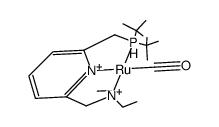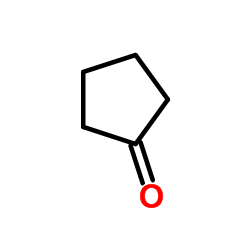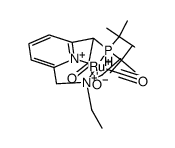863971-63-5
| Name | Carbonylhydrido[6-(di-t-butylphosphinomethylene)-2-(N,N-diethylaminomethyl)-1,6-dihydropyridine]ruthenium(II) Milstein Catalyst |
|---|---|
| Synonyms | Milstein Catalyst |
| Molecular Formula | C20H35N2OPRu |
|---|---|
| Molecular Weight | 451.54800 |
| Exact Mass | 452.15300 |
| PSA | 21.76000 |
| LogP | 4.64480 |
|
Section 1: Product Identification Carbonylhydrido[6-(di-t-butylphosphinomethylene)-2-(N,N-diethylaminomethyl)-1,6-dihydropyridine]ruthenium(I Chemical Name: I), min. 98% Milstein Catalyst CAS Registry Number:863971-63-5 Formula:C20H35N2OPRu EINECS Number:none
Chemical Family:organometallic complex Carbonylhydrido[2-(N,N-diethylaminomethyl)-6-(di-t-butylphosphanomethylene)-1,6-dihydropyridine]ruthenium Synonym: (II), min. 98% Section 2: Composition and Information on Ingredients IngredientCAS NumberPercentACGIH (TWA)OSHA (PEL) Title compound863971-63-5100%no datano data Section 3: Hazards Identification Emergency Overview:Irritating to skin, eyes and respiratory tract Primary Routes of Exposure:Inhalation, skin, eyes Eye Contact:Causes slight to mild irritation of the eyes. Skin Contact:Causes irritation to the skin Inhalation:Causes irritation to the nose, mucous membranes and respiratory tract Ingestion:No information on the physiological effects of ingestion. May be harmful if swallowed. Acute Health Affects:Irritating to skin, eyes and respiratory tract Chronic Health Affects:No information available on long-term chronic effects NTP:No IARC:No OSHA:No SECTION 4: First Aid Measures Immediately flush the eyes with copious amounts of water for at least 10-15 minutes. A victim may need Eye Exposure: assistance in keeping their eye lids open. Get immediate medical attention. Wash the affected area with water. Remove contaminated clothes if necessary. Seek medical assistance if Skin Exposure: irritation persists. Remove the victim to fresh air. Closely monitor the victim for signs of respiratory problems, such as difficulty Inhalation: in breathing, coughing, wheezing, or pain. In such cases seek immediate medical assistance. Seek medical attention immediately. Keep the victim calm. Give the victim water (only if conscious). Induce Ingestion: vomiting only if directed by medical personnel. SECTION 5: Fire Fighting Measures Flash Point:not applicable Autoignition Temperature:none Explosion Limits:none Extinguishing Medium:carbon dioxide, dry chemical or foam If this product is involved in a fire, fire fighters should be equipped with a NIOSH approved positive pressure Special Fire Fighting Procedures: self-contained breathing apparatus and full protective clothing. Hazardous Combustion andIf involved in a fire, this material may emit toxic organic fumes Decomposion Products: Unusual Fire or Explosion Hazards: No unusual fire or explosion hazards SECTION 6: Accidental Release Measures Small spills can be mixed with vermiculite, sodium carbonate or other suitable non-combustible adsorbent and Spill and Leak Procedures: swept up. SECTION 7: Handling and Storage Handling and Storage:Store cold, in a tightly sealed container, under an inert atmosphere of nitrogen or argon. SECTION 8: Exposure Controls and Personal Protection Eye Protection:Always wear approved safety glasses when handling a chemical substance in the laboratory. Skin Protection:Wear protective clothing and gloves. Ventilation:Handle the material in an efficient fume hood. If ventilation is not available a respirator should be worn. The use of respirators requires a Respirator Respirator: Protection Program to be in compliance with 29 CFR 1910.134. Ventilation:Handle the material in an efficient fume hood. Additional Protection:No additional protection required. SECTION 9: Physical and Chemical Properties Color and Form:red-black solid Molecular Weight:451.55 Melting Point:no data Boiling Point:no data Vapor Pressure:no data Specific Gravity:no data Odor:not determined Solubility in Water:insoluble SECTION 10: Stability and Reactivity Stability:air sensitive, store cold Hazardous Polymerization:no hazardous polymerization Conditions to Avoid:none Incompatibility:oxidizing agents, halogens and active metals Decomposition Products:carbon monoxide, carbon dioxide, ruthenium oxide and organic fumes SECTION 11: Toxicological Information RTECS Data:No information available in the RTECS files Carcinogenic Effects:No data Mutagenic Effects:No data Tetratogenic Effects:No data SECTION 12: Ecological Information Ecological Information:No information available SECTION 13: Disposal Considerations Disposal:Dispose of according to local, state and federal regulations SECTION 14: Transportation Shipping Name (CFR):Non-hazardous Hazard Class (CFR):NA Additional Hazard Class (CFR):NA Packaging Group (CFR):NA UN ID Number (CFR):NA Shipping Name (IATA):Non-hazardous Hazard Class (IATA):NA Additional Hazard Class (IATA):NA Packaging Group (IATA):NA UN ID Number (IATA):NA SECTION 15: Regulatory Information TSCA:Not listed in the TSCA inventory SARA (Title 313):Title compound not listed Second Ingredient:none SECTION 16 - ADDITIONAL INFORMATION N/A |
|
~% 
863971-63-5 |
| Literature: Zhang, Jing; Leitus, Gregory; Ben-David, Yehoshoa; Milstein, David Angewandte Chemie - International Edition, 2006 , vol. 45, # 7 p. 1113 - 1115 |
|
~% 
863971-63-5 |
| Literature: Zhang, Jing; Leitus, Gregory; Ben-David, Yehoshoa; Milstein, David Journal of the American Chemical Society, 2005 , vol. 127, # 31 p. 10840 - 10841 |
|
~% 
863971-63-5 |
| Literature: Huff, Chelsea A.; Kampf, Jeff W.; Sanford, Melanie S. Chemical Communications, 2013 , vol. 49, # 64 p. 7147 - 7149 |
|
~% 
863971-63-5 |
| Literature: Huff, Chelsea A.; Kampf, Jeff W.; Sanford, Melanie S. Chemical Communications, 2013 , vol. 49, # 64 p. 7147 - 7149 |
|
~% 
863971-63-5 |
| Literature: Huff, Chelsea A.; Kampf, Jeff W.; Sanford, Melanie S. Organometallics, 2012 , vol. 31, # 13 p. 4643 - 4645 |
| Precursor 1 | |
|---|---|
| DownStream 0 | |






